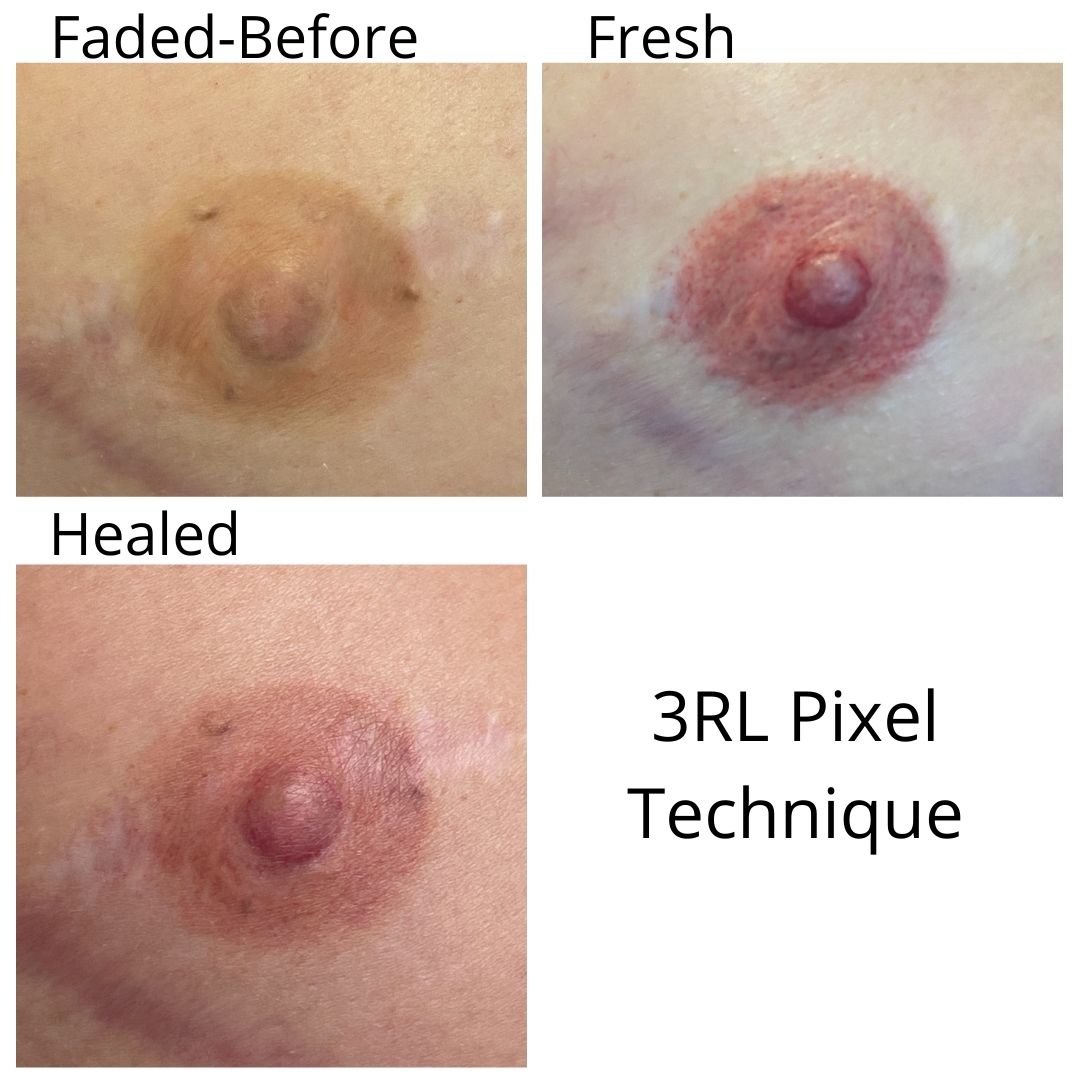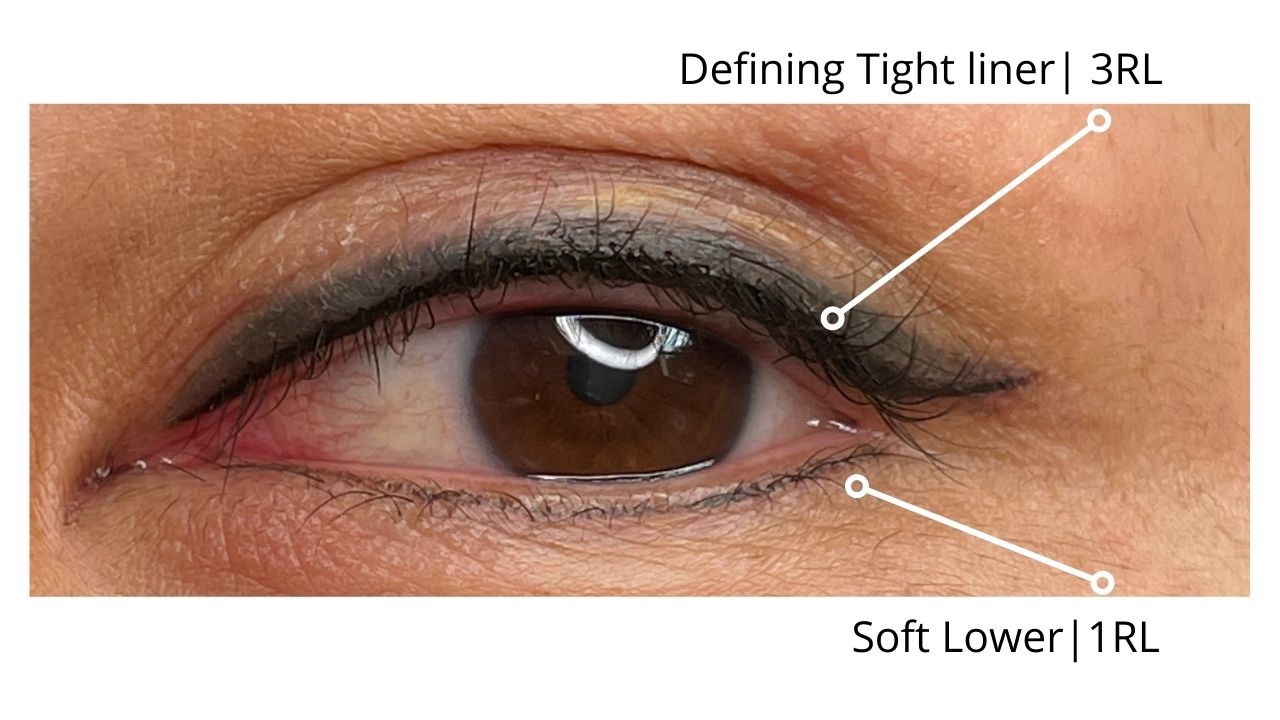Areola Tattoo Techniques
 Usually I employ several techniques when Im working on a procedure, especially when Im tattooing an areola. This is a 4 year faded case when the initial goal had started more of a tan soft color.
Usually I employ several techniques when Im working on a procedure, especially when Im tattooing an areola. This is a 4 year faded case when the initial goal had started more of a tan soft color.
My client wanted more pink so I incorporated a couple different pink tones over the existing color trying to create some texture variations with color. Since the color had faded and was rather flat, the pinks showed up over the top.
I find that If the previous ink color isn't too dark, tattooing over it turns out nice for both areolas, brows and lips and even eyes. The new ink, instead of finding its placement in the skin has some type of substrate (previous ink) to "grab".
The pixel technique, that leaves open color space, is quite effective over previous color and it also lets the previous color glow through. I used a 3RL instead of a 1RL. so that I could get in more color and see more texture from the bigger needle grouping. ( A single needle won't give enough texture in thi...
What Can I do for Breast Cancer Month?

We all like to help and this is one way to reinforce your relationship with referring doctors and also a way to reach potential new referral sources.
Donating a procedure on behalf of the doctor or other business puts them in good light and you as well.
Here's some verbiage you can use on a gift certificate that the doctor can give to a patient per their discretion:
A special gift
On behalf of Dr. XXXXXXX
Your Name, Permanent Cosmetic Expert, offers you an Areola Tattoo procedure.
The permanent cosmetic restoration phase is the final step after breast reconstruction. The natural appearance of the restorative tattooing procedure brings back the shape and color of the areola complex.
This is simple and the certificates can be given to the doctors or business of your choice.
To your PMU success,

PMU Artist & Needle Specialist
Inside Needle Knowledge
Purchase the I.N.K. Course Now
IG jillhoyer
Tattooing over previous eyeliner

Taking a previous thicker faded liner and refreshing it doesn't always require the new artist to follow the existing design.
At first, my client requested a new soft thin lower liner and a solid black upper liner cover up over her 6 year faded permanent makeup. Although I personally don't begin new liner with wings or tails, I could either darken over previous work or I have an option to create a new design. I explained to my client that her faded steely grey-blue liner could act as a shadow above a black, dark defined line in the lash line. I also thought this would look nice with the soft lower line request. She liked the new design idea so I tattooed it.
Note that the previous work has yellowish color above the old line. This is usually a highlight that could have been white and turned yellow over time, or there was a dark mistake that the artist tried to cover with lighter ink. In this case, the highlight looks like faded white ink that yellowed. This is sometimes ref...
PMU Needle Cartridge Chart
Hello PMU Artists,
I thought there was a boom in our needle choices and I was mistaken. There is an explosion!
Isn't is a challenge to keep track of your needle favorites and which companies sell what sizes in the variety of configurations? I love needles and it's quite exciting to see what's coming to market for our PMU industry.
Of course, you could use most standard tattoo needle cartridges labeled for the tattoo industry or for the PMU industry in our procedures, however I must say, Im proud of the PMU industry pushing to the forefront and creating great products and a variety of needle choices for the variety rotary machines we have available to us today.
I decided to start a log sheet of some of the "PMU" needle cartridges available. This is by no way all of them and keep in mind, you could use most cartridges so long as the needles are the size, taper and configuration are you want for your artistry.
There is an abundance of needle cartridges available so this is just...
Curved Magnum Techniques for Eyebrows
There are so many new cartridge needles coming to market! This will be fun to try. Right now Im trying the Tina Davies new needles. They are unique because of the very long taper, which makes the needles flexible and have give in the skin.
We all know there are several ways to use our needles as it comes down to our permanent makeup artistry. Im sharing ⬆️⬅️the 2 ways in the brow video using a curved magnum on the side and flat using the width of the needle cartridge.
The soft airbrushed background will reveal itself lighter in a few days and be ready for another color and technique layer in a few weeks.
🔮WHAT NEXT?
The pixel result with a single or a 3RL (on top of my soft background) adds texture and dimension so I might do that over the healed brows.
♥️Unique
♥️Brushy
♥️Flexible
By Tina Davies Professional
👜Try a sampler pack of needles 15% off with JILLHOYER15 https://glnk.io/j3y3/jillhoyer
To your PMU success,

PMU Artist & Needle Specialist
Inside Needle Knowledge
Purchase ...
The Power of Pixels
Even on areola pixels add nice texture and dimension over my healed areola for texture and dimension with a .2503RL. or sometimes a 1Rl.
The TD needles have give are flexible and create perfect pixels with the long taper!
To your PMU success,

PMU Artist & Needle Specialist
Inside Needle Knowledge
Purchase the I.N.K. Course Now
IG jillhoyer
Five Curved Magnum vs Five Stacked Magnum
Just by the name "5 Magnum" these two needle cartridges seem like they would be similar, however, the words curved and stacked are what make these needles quite unique.
Imagine the pattern difference between these to 5 magnums. The curved magnum will leave a loose ink pattern in the skin verses the 5 stacked magnum, which will leave a denser ink pattern.
The hand movements with these needles in my experience are different. With a curved magnum I can move with loose ovals, forward brushing, back brushing and pendulum movements.. Where as the stacked mag, will require more forward type movements and less side to side movements or the sharp corners can tear or create nicks in the skin.
I personally prefer the looser curved magnum because of the freedom of movements I can do, but I know artists do nice work with the stacked magnum.
Each needle requires unique hand movements.
Any questions? Feel free to just email me! [email protected]
To your PMU success,
...Curved Magnums-YES!
Why am I a fan of curved magnums? The curved magnum changed my artistry. Back when I started in the PMU world, I was using a machine that only proprietary cartridge needles would fit into. What that meant was that I was limited to certain needle groupings. Learning permanent makeup was hard enough, but these needles just didn't make sense to me....they were suppose to be my paint brushes so to speak and they didn't speak to me.
I ventured out and bought a tattoo machine that accepted several cartridge needle configurations in all shapes and sizes. I remember trying a 23 curved magnum on a practice pad. I thought how much quicker my procedures would be and the ease of creating a smooth pattern seemed effortless. As I continued to try different configurations such a larger round shaders 9,11 etc. I was continually impressed with the magnums. A 13 curved magnum for cosmetic procedures and larger such as a 17 curved magnum for areola tattooing became my favorites.
The benefit of a...
What's the difference between a liner and magnum tattoo needle?

Aside from the actual configuration difference and how the needles line up, a round liner and a magnum also give different effects when tattooing. The above photo are seperate examples of a round liner and a magnum used for eyebrows and also used on a practice pad. I've used the same pendulum motion technique and the same machine speed on the practice pad to demonstrate the different effects of these needle configurations.
Liner needles are typically grouped in a circle and the needles are soldered tight together. When used for a pixel technique they can give a textured effect especially a 3 round liner for example. A single needle can give texture as well, however depending on the technique used, you can also get an airbrushed effect similar to a magnum from a single needle, it just takes time to build up the color. Liners give you the opportunity to leave untouched skin space where there's no to minimal color deposited in the skin and also are great when you need to add textu...
Needle Clarity
Several needle manufacturers include bugpin size needles and nano sizes in cartridge needles and manual needles. When deciphering tattoo needle sizes, bugpins, nanos, and taper, all come into play in different ways.
Bugpins are usually .30 or smaller, however when the sizes get really small they are referred to as "nano" size needles. There are no rules so to speak on what exact size needle is a bugpin or a nano, as that is up to the manufacturer to label the needles. It would be safe to say that a .12, .15, and a .18 are considered nanos.
A tip to remember:
✅The taper determines the end size of the needle as it touches the skin.
We don’t always have exact taper information but you can identify it if it’s listed on the packaging code or use an eye loupe to help.
Hope that helps with needle clarity and some of the terms we hear today as PMU artists.
- To your PMU success,

PMU Artist & Needle Specialist
Inside Needle Knowledge
Purchase the I.N.K. Course Now
IG jillhoyer
